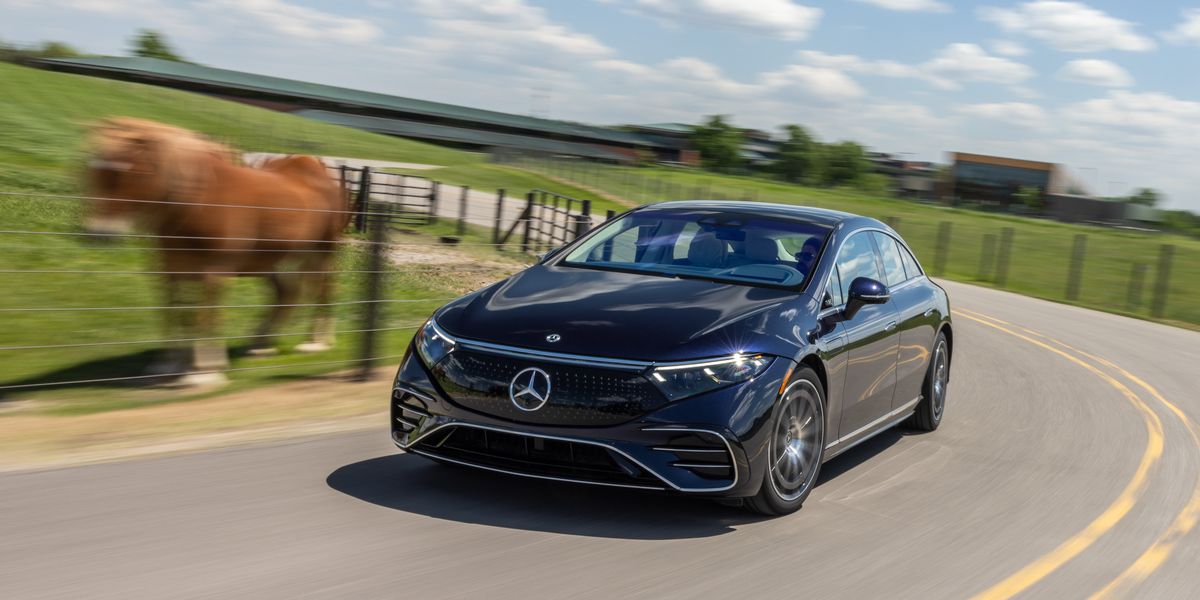2022 Mercedes-Benz EQS580 4Matic Tested: More IQ Than EQ

From the July/August 2022 issue of Car and Driver.
Perhaps Mercedes should rename its EQ subbrand IQ, because the 2022 Mercedes-Benz EQS580 feels as if it were developed to appeal to individuals with the emotional quotient of Mark Zuckerberg and the intelligence quotient of Albert Einstein.
Although its two electric motors (one at each axle) produce a healthy 516 horsepower, the all-wheel-drive EQS580 is an aloof machine that offers minimal engagement when driven vigorously. All of that grunt pushed the EQS580 to 60 mph in 3.7 seconds and rocketed it from 30 to 50 mph in 1.5 ticks. But a 489-hp Tesla Model S Long Range Plus hit these same marks in 3.5 and 1.4 seconds, respectively. Blame the 982 pounds of extra mass the Mercedes carries for its lesser straight-line performance.
Andi HedrickCar and Driver
HIGHS: Hyperscreen lives up to the hype, cavernous cargo hold, quiet cabin.
At 5806 pounds, the EQS’s near-G-class curb weight is an anchor on efficiency, which surely explains the jelly-bean styling that favors function over form. Though aesthetically unfortunate, the ’90s-era cab-forward look is a wise decision. It contributes to a coefficient of drag of 0.20 and helped the 580, with its 107.8-kWh battery pack, travel 350 miles on our 75-mph range test—one of few EVs that beat its EPA range. The shape also helps limit noise inside the cabin to 64 decibels during 70-mph cruising, the same level recorded in the S580.
Andi HedrickCar and Driver
Unfortunately, this battery-powered sedan lacks the cosseting rear seat of its gas-powered Benz kin. The plunging roofline limits headroom back there, a situation exacerbated by the fixed seatback’s upright angle. The EQS’s hatchback configuration, however, provides more cargo space than even the GLC-class SUV.
LOWS: Dimwitted brake pedal, limited rear-seat headroom, exceptionally heavy.
The driver and front passenger suffer from no such compromises on space or comfort. They also gaze at a massive infotainment system that houses three separate display screens under a 56.0-inch glass panel. Dubbed the Hyperscreen, the setup smartly incorporates high-resolution graphics and reacts quickly to inputs (by touch or via the car’s capacitive buttons), making it reasonably easy to operate, even if we wish Mercedes included at least a few redundant hard buttons.
The EQS hood doesn’t open, so Mercedes put a washer-fluid door on the left front fender, obviously.
Austin IrwinCar and Driver
More irksome, however, is the brake-pedal operation. Applying pressure to the unsettlingly disconnected-feeling left pedal is akin to pushing Play-Doh through a mold. Switching the regenerative braking system to its strongest setting limits the need to interact with the brakes, as it enables the one-pedal driving mode, which also actively moves the brake pedal as the regen function decelerates the car (mimicking the pedal’s position had you actually stepped on it). Besides the strangeness of all of this, the variability of the pedal’s phantom motions makes it difficult for the driver to quickly apply the brakes when additional stopping power is required. It’s a surprisingly low-IQ feature in a car that otherwise ought to appeal to high-IQ buyers.
A car-lover’s community for ultimate access & unrivaled experiences. JOIN NOW

This content is created and maintained by a third party, and imported onto this page to help users provide their email addresses. You may be able to find more information about this and similar content at piano.io



